Monreale - the Cathedral (Duomo)
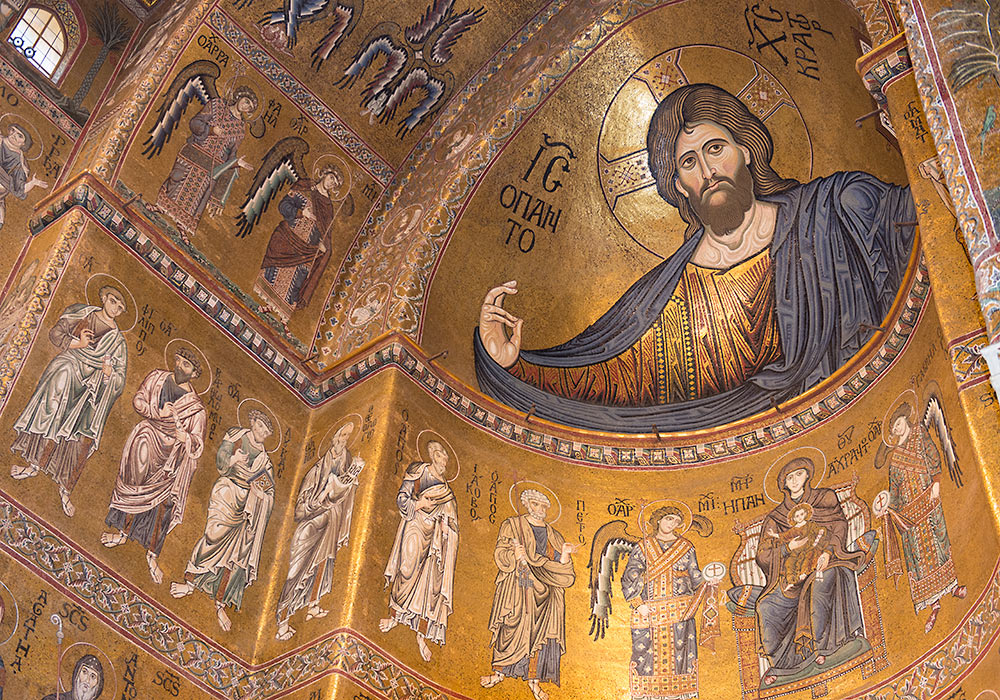
The Cathedral in Monreale - built between 1170 and 1189 - is inscribed on UNESCO’s World Heritage List.
Christ Pantocrator: The cathedral in Monreale, Palermo, is regarded as the most beautiful of the Norman churches in Sicily. The mosaics were made with 2200 kg of pure gold, experts have estimated. Craftsmen from Constantinople were employed to expedite the work. The Byzantine mosaics are among the most magnificent in the world.
According to Dr. Ute Dercks (Kunsthistorisches Institut in Florenz, Max-Planck-Institut), documentary evidence dates the royal construction project to 1174, although initiatives in planning and preparation can be projected back to the death of King William I in 1166.
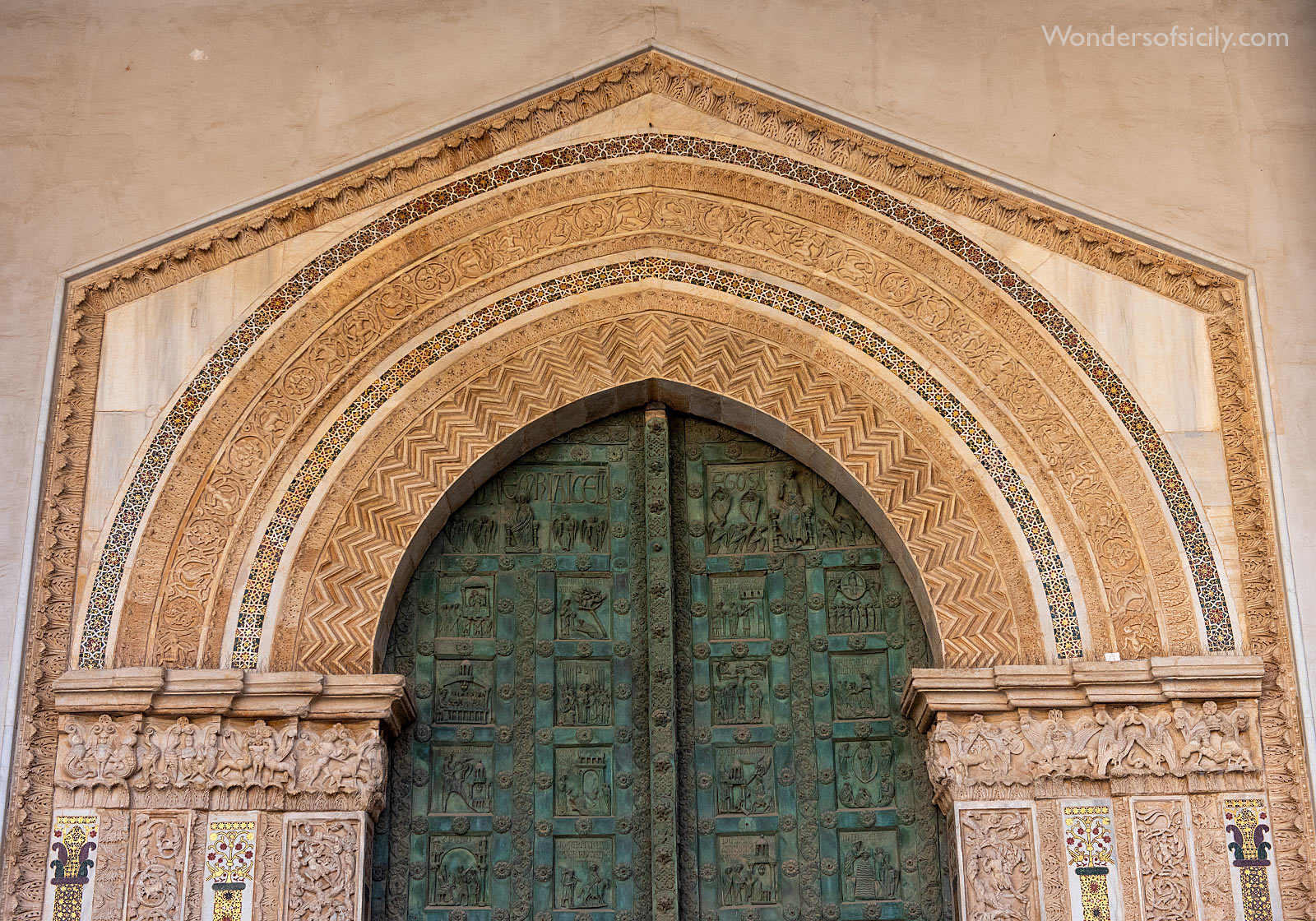
Porta del Paradiso, the main portal/gate on Monreale cathedral, c. 1186. Photo: Per-Erik Skramstad
The bronze door was made by the Italian sculptor Bonanno Pisano who was active in the 1170s and 1180s.
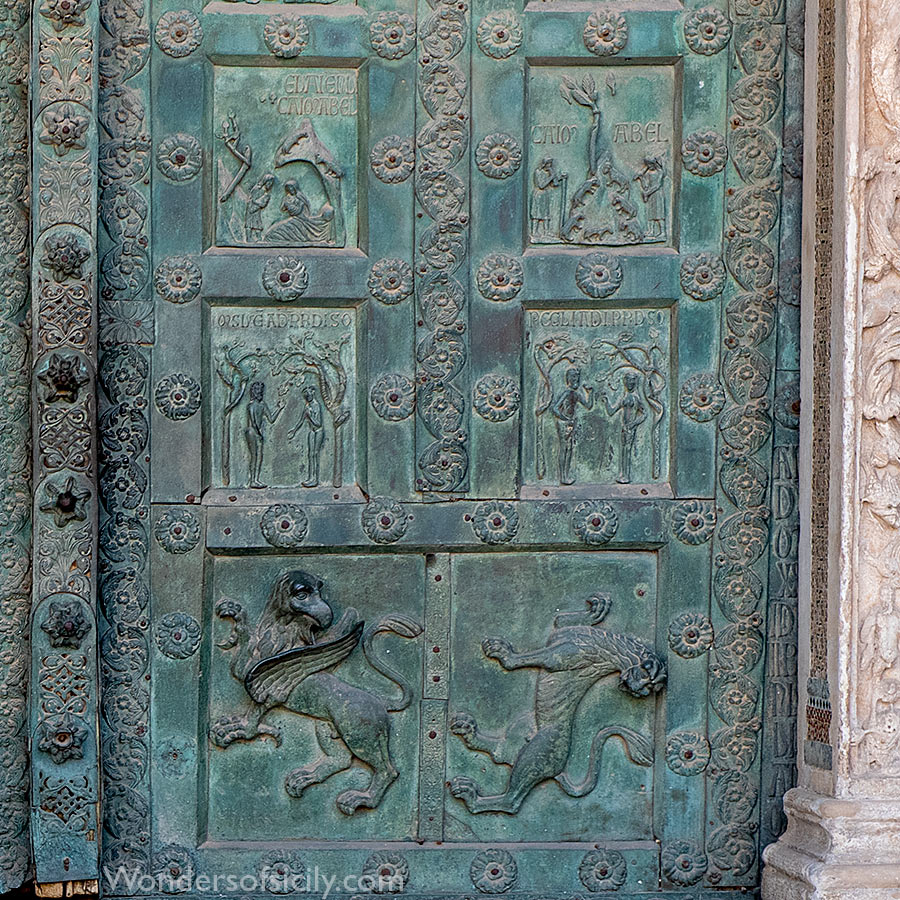
Detail of the bronze door (Bonanno Pisano, c. 1186). Notice the vertical lion to the right.
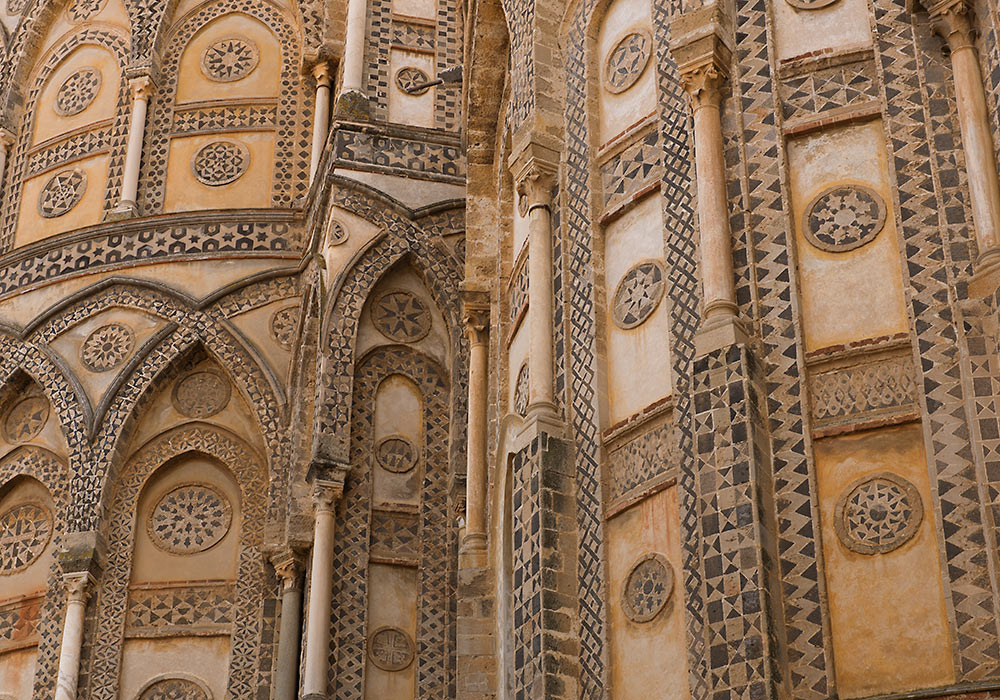
"Monreale" is a contraction of monte-reale, "royal mountain". The outsides of the principal doorways and their pointed arches are magnificently enriched with carving and colored inlay, a curious combination of three styles - Norman-French, Byzantine and Arab.
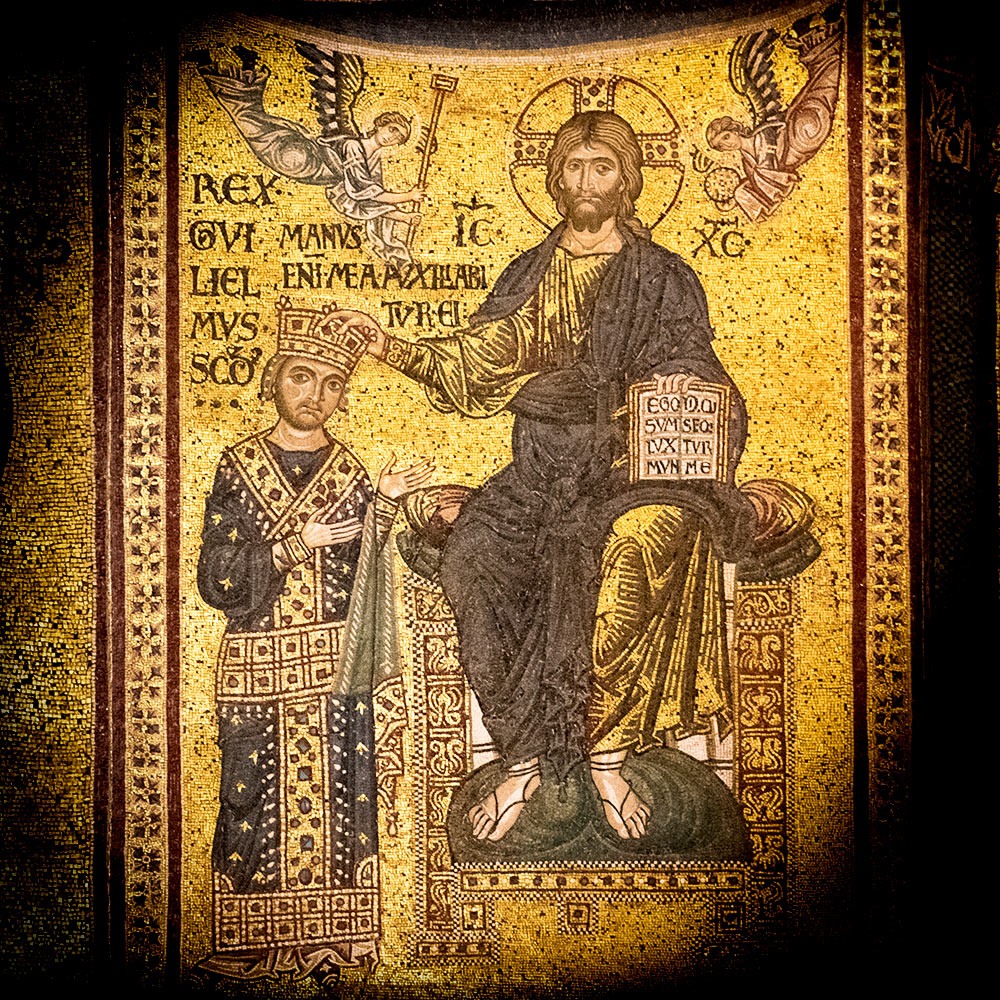
Christ crowning William II, Monreale Cathedral.
UNESCO’s World Heritage List
Arab-Norman Palermo and the Cathedral Churches of Cefalú and Monreale (Italy) - new on the list (2015)
Located on the northern coast of Sicily, Arab-Norman Palermo includes a series of nine civil and religious structures dating from the era of the Norman kingdom of Sicily (1130-1194): two palaces, three churches, a cathedral, a bridge, as well as the cathedrals of Cefalú and Monreale. Collectively, they are an example of a social-cultural syncretism between Western, Islamic and Byzantine cultures on the island which gave rise to new concepts of space, structure and decoration. They also bear testimony to the fruitful coexistence of people of different origins and religions (Muslim, Byzantine, Latin, Jewish, Lombard and French).
Palermo
- Palazzo dei Normanni (The Norman Palace)
- Cappella Palatina (The Palatine Chapel in the Norman Palace)
- Church of San Giovanni degli Eremiti
- Church of Santa Maria dell'Ammiraglio (also known as the Martorana)
- Church of San Cataldo
- Cathedral of Palermo
- The Zisa Palace (La Zisa)
- The Cuba Palace (La Cuba)
Norman Cathedrals
Christ Pantocrator
The most common translation of Pantocrator is "Almighty" or "All-powerful". In this understanding, Pantokrator is a compound word formed from the Greek words pan (gen. pantos), i.e. "all" and kratos, i.e. "strength", "might", "power". This is often understood in terms of potential power; i.e., ability to do anything, omnipotence. Another, more literal translation is "Ruler of All" or, less literally, "Sustainer of the World". In this understanding, Pantokrator is a compound word formed from the Greek for "all" and the verb meaning "To accomplish something" or "to sustain something" (κρατεω). This translation speaks more to God's actual power; i.e., God does everything (as opposed to God can do everything).
More photos of the Cathedral in Monreale
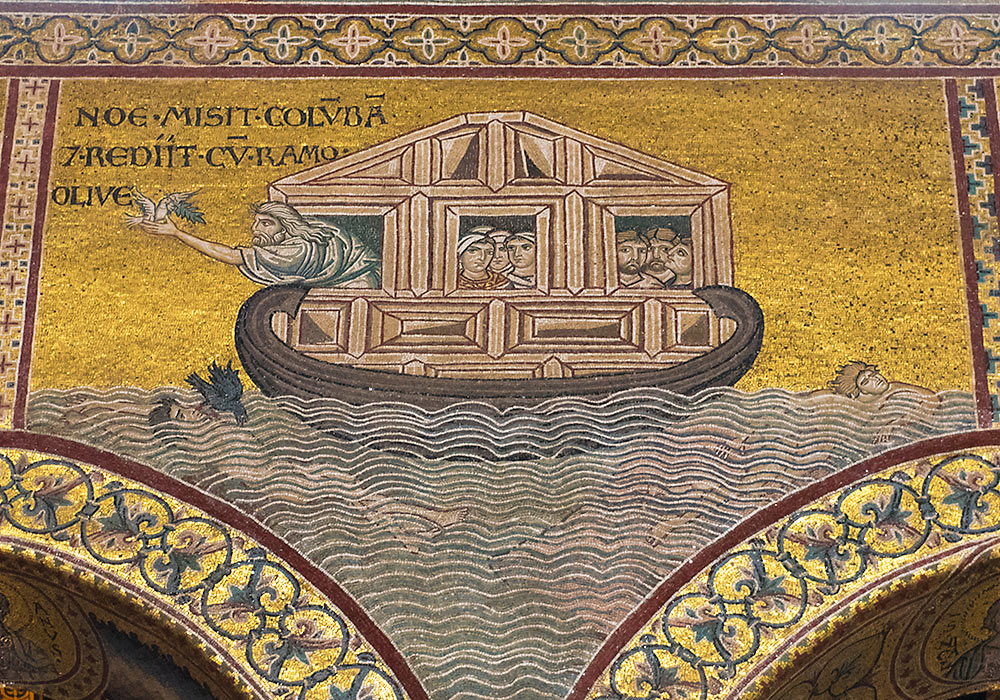
Mosaics on the south wall: Cycle of the Old Testament. Noah is greeting the dove returning with an olive leaf.
7 And he sent forth a raven, which went forth to and fro, until the waters were dried up from off the earth. 8 Also he sent forth a dove from him, to see if the waters were abated from off the face of the ground; 9 But the dove found no rest for the sole of her foot, and she returned unto him into the ark, for the waters were on the face of the whole earth: then he put forth his hand, and took her, and pulled her in unto him into the ark. 10 And he stayed yet other seven days; and again he sent forth the dove out of the ark; 11 And the dove came in to him in the evening; and, lo, in her mouth was an olive leaf pluckt off: so Noah knew that the waters were abated from off the earth. (GENESIS chapter 8, King James)
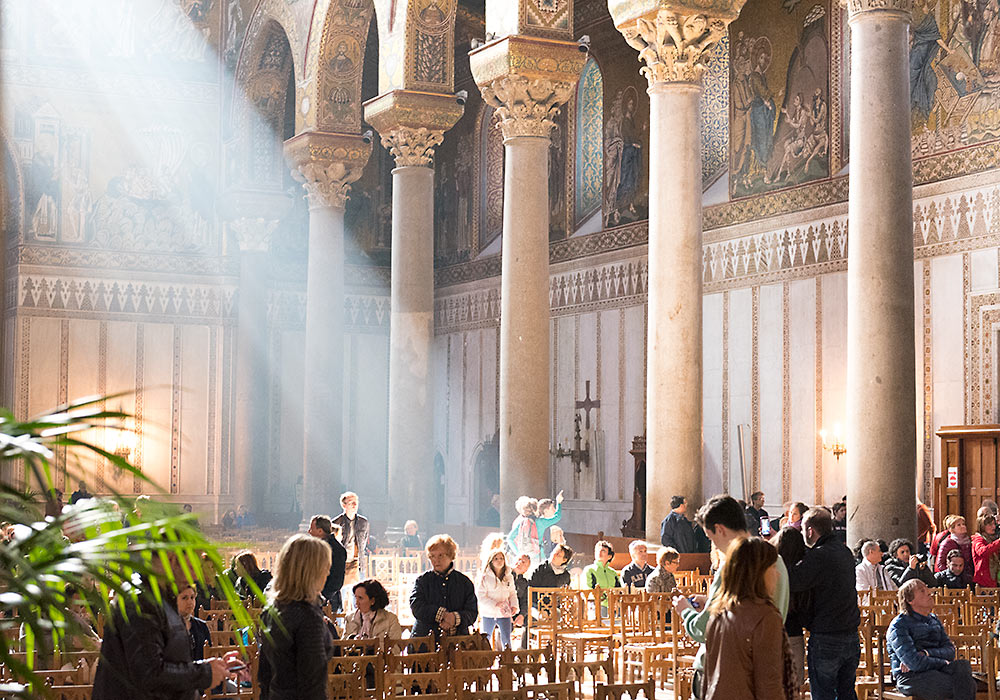
The interior of the Monreale cathedral with a spectacular effect as the sun rays illuminates the interior.
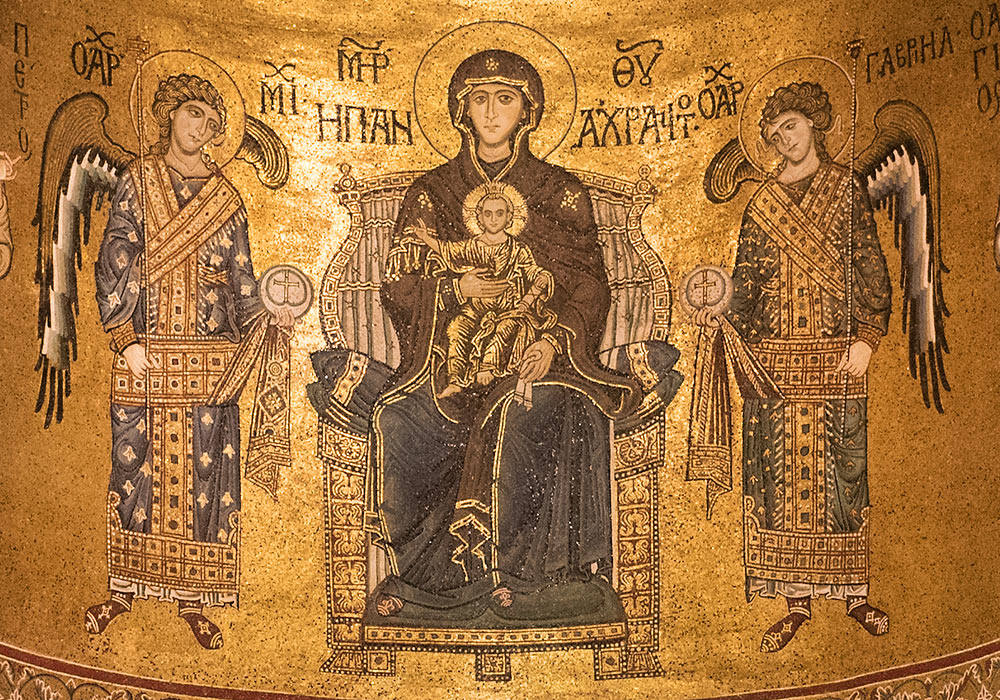
The Virgin and Child enthroned.
According to a blog about Russian, Greek, and Balkan icons, Icons and their Interpretation, the inscriptions on either side of the Virgin’s head follows the standard abbreviation for "Mother of God" (ΜΡ ΘΥ, Meter Theou) commonly found in Marian imagery, with a notable variation where ΜΡ is expanded to a three-letter abbreviation (ΜΗΡ/ΜΕΡ). However, the primary focus is the longer inscription below: ΗΠΑΝ ΑΧΡΑΝΤΟ, which, when properly spaced and corrected, reads Η ΠΑΝΑΧΡΑΝΤΟΣ.
This phrase corresponds to the Greek title Παναγία ή πανάχραντος (Panagia he Panakhrantos), meaning "The All-Holy Most Immaculate One." The etymology of the term is as follows:
- Pan ‘All’
- Hagia ‘Holy’
- Khrantos ‘Stained’ or ‘Defiled’
- A- A negation, meaning ‘Not’ or ‘Un-’
Thus, Πανάχραντος (Panakhrantos) translates literally as "All-Unstained," often rendered in English as "Most Immaculate." Within Eastern Orthodox tradition, this title refers to the sinlessness of the Virgin Mary, though interpretations vary. Some theologians assert she was free from actual sin, others that she never sinned, and some emphasize that she died sinless.
Read more on Icons and their Interpretation...
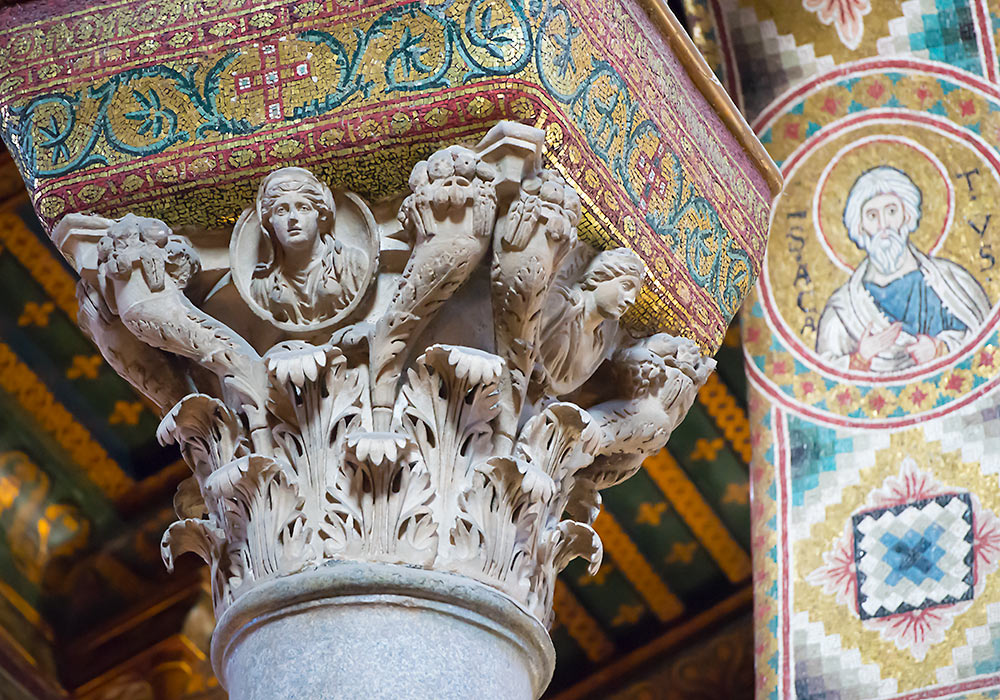
A beautiful capital in the cathedral. The columns are of Roman origin.
Click here to see a selection of photos of capitals in Sicily
CLICK HERE to see photos from the cloister at Monreale!
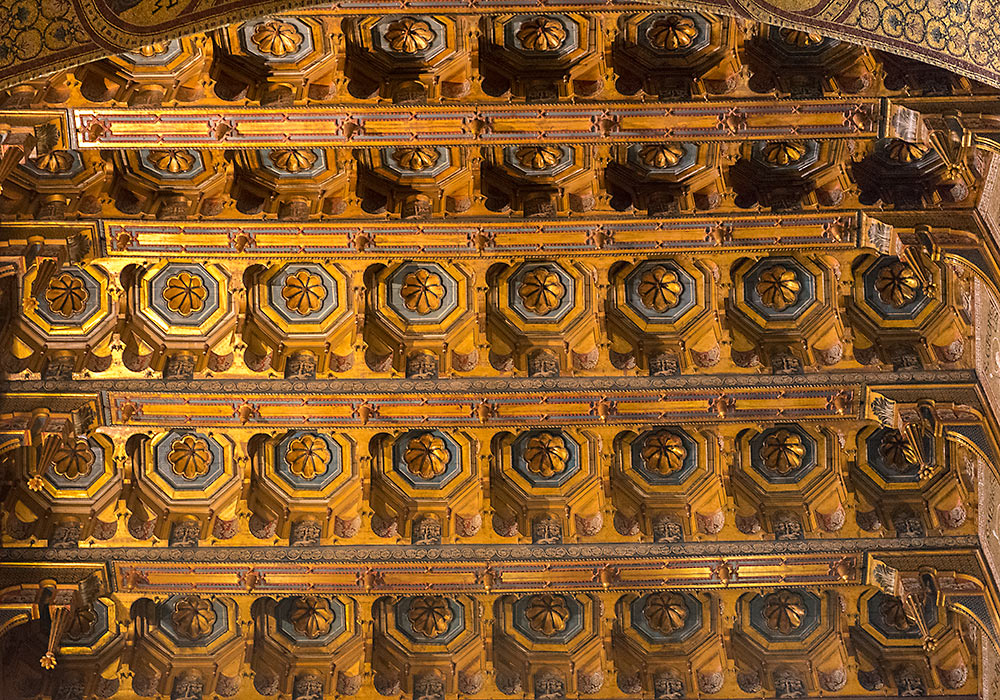
Detail of the restored ceiling.
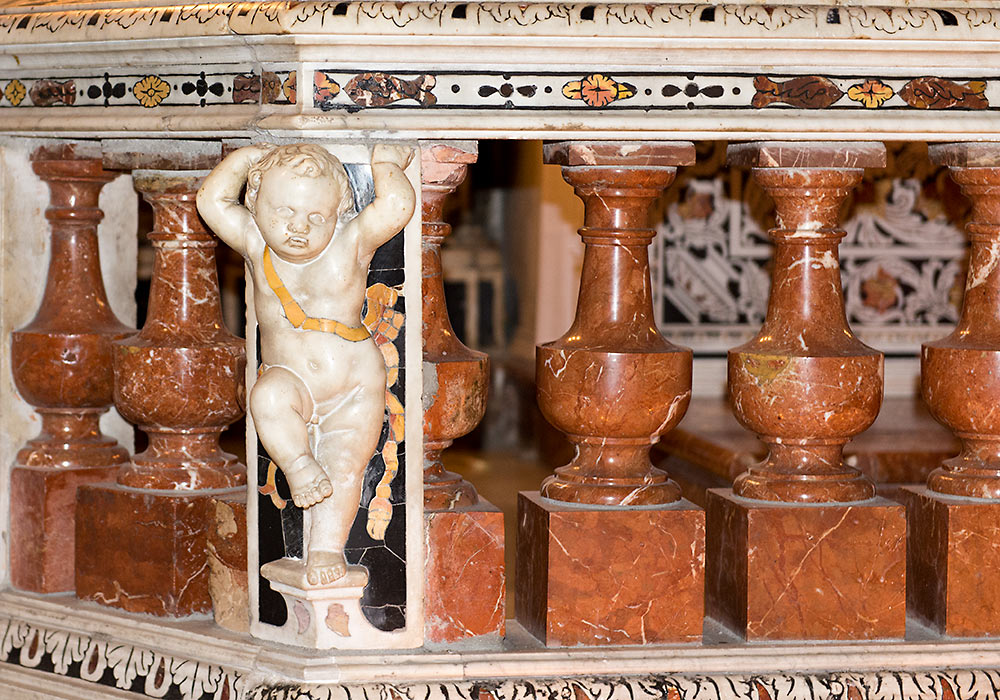
Little putto with big job to do. Detail of the interior fram the baroque period.
The term "Normans" (“men from the North”) applied first to the people of Scandinavia in general, and afterwards (Northmannus, Normannus, Normand) it is the name of the Viking colonists from Scandinavia who settled themselves in Gaul and founded Normandy. The Normans’ adopted a new religion (became Christians), a new language, a new system of law and society, new thoughts and feelings on all matters.
From their new home in northern France they set forth on new errands of conquest, chiefly in the British Islands and in southern Italy and Sicily.
If Britain and Sicily were the greatest fields of their enterprise, they were however very far from being the only fields. The same spirit of enterprise which brought the Northmen into Gaul seems to carry the Normans into every corner of the world. The conquest of England was made directly from Normandy, by the reigning duke, in a comparatively short time, while the conquest of Sicily grew out of the earlier and far more gradual conquest of Apulia and Calabria by private men, making their own fortunes and gathering round them followers from all quarters. They fought simply for their own hands, and took what they could by the right of the stronger.
They started with no such claim as Duke William put forth to justify his invasion of England; their only show of legal right was the papal grant of conquests that were already made. The conquest of Apulia, won bit by bit in many years of what we can only call freebooting, was not a national Norman enterprise like the conquest of England, and the settlement to which it led could not be a national Norman settlement in the same sense.
The Sicilian enterprise had in some respects another character. By the time it began the freebooters had grown into princes. Sicily was won by a duke of Apulia and a count of Sicily. Warfare in Sicily brought in higher motives and objects. Althought this was before the Crusades, the strife with the Muslims at once brought in the crusading element. Duke William was undisputed master of England at the end of five years; it took Count Roger thirty years to make himself undisputed master of Sicily. The one claimed an existing kingdom, and obtained full possession of it in a comparatively short time; the other formed for himself a dominion bit by bit, which rose to the rank of a kingdom.
Professor Robert Bartlett describes their exit like this in the excellent BBC documentary “The Normans”: “The Normans simply disappeared. This might sound like failure, but in fact it was the key to their success. They weren’t interested in the purity of their blood. They came, they saw, they conquered. Then they married the locals, learnt the language, and assimilated themselves out of existence.”
Links to more information about the Normans
- The Norman Conquest (Medievalsicily.com)
- Sicilian Peoples: The Normans by L. Mendola and V. Salerno (Bestofsicily.com)
- Tracing the Norman Rulers of Sicily by Louis Inturrisi (The New York Times)
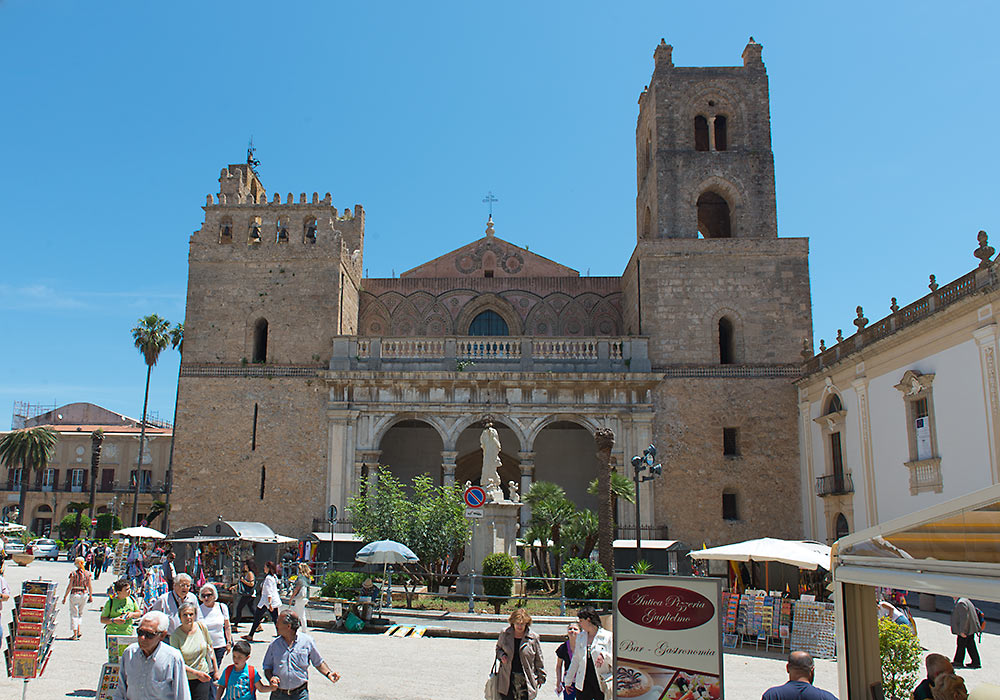
The cathedral in Monreale marks the high point of the marriage between Norman Romanesque Architecture and Byzantine craftsmanship.
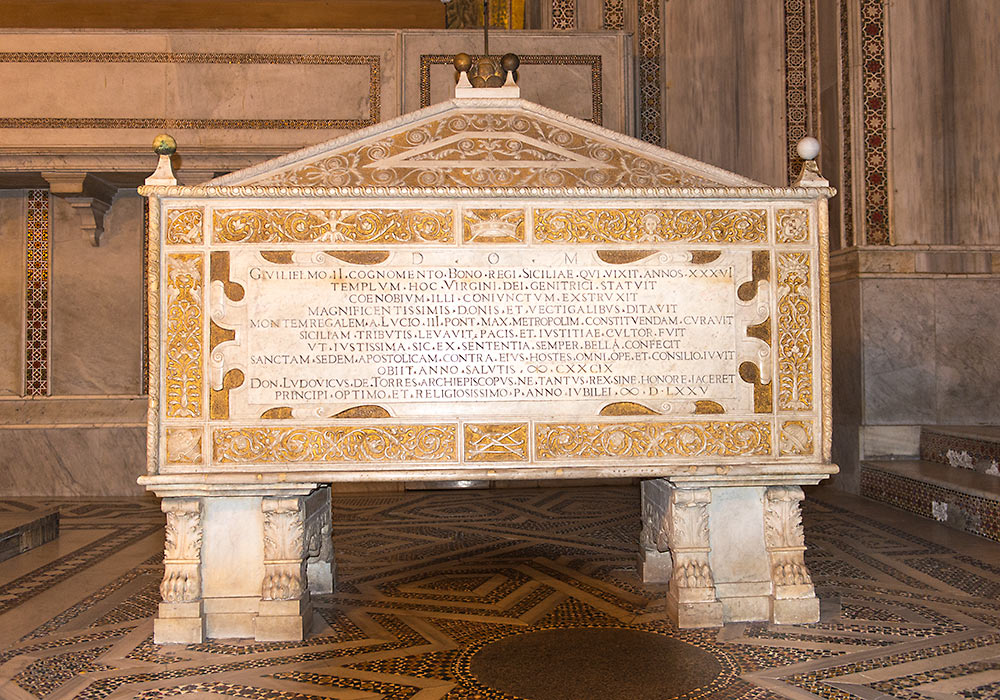
The Tomb of King William II of Sicily in the Monreale Cathedral.
Related links
- Depictions of Jesus (as Christ Pantocrator) in Sicily
- The Monreale Cathedral
- The Cefalù Cathedral
- Mosaics in Sicily
- Churches in Sicily
The Normans in South Italy
999–1017 Arrival of the Normans in Italy
1009–1022 Lombard revolt
1022–1046 Mercenary service
1046–1059 County of Melfi
1049–1098 County of Aversa
1053–1105 Conquest of the Abruzzo
1061–1091 Conquest of Sicily
1073–1077 Conquest of Amalfi and Salerno
1059–1085 Byzantine-Norman wars
1077–1139 Conquest of Naples
1091: The county of Ragusa was founded in 1091 by Count Roger for his son, Godfrey.
1095: 22 December Roger II is born
1105: Roger II is named Count of Sicily
1127: Roger II becomes Duke of Apulia and Calabria
1130: Roger II becomes King of Sicily
1130s Cappella Palatina: Commenced by Roger II
1131 Building of the cathedral in Cefalù begins (Roger II)
1140 Cappella Palatina is consecrated.
c1140-c1147 The painted wooded ceiling in Cappella Palatina was completed
1143–1151 The mosaics in La Martorana (Santa Maria dell'Ammiraglio) was made
1154: 26 February Roger II dies and William I becomes King of Sicily
1154-1166: The mosaics of the central nave of the Cefalù Cathedral and the nave and aisles of the Palatine Chapel (Cappella Palatina) were most likely made during the rule of William I
1160-70 c. Sala di Ruggero (King Roger's Room) in the Norman Palace is made
1166: 7 May King William I dies in Palermo
1174–1189 The cathedral in Monreale is built (King William II)
1194 Sicily falls into the hands of the Germanic Hohenstaufen dynasty
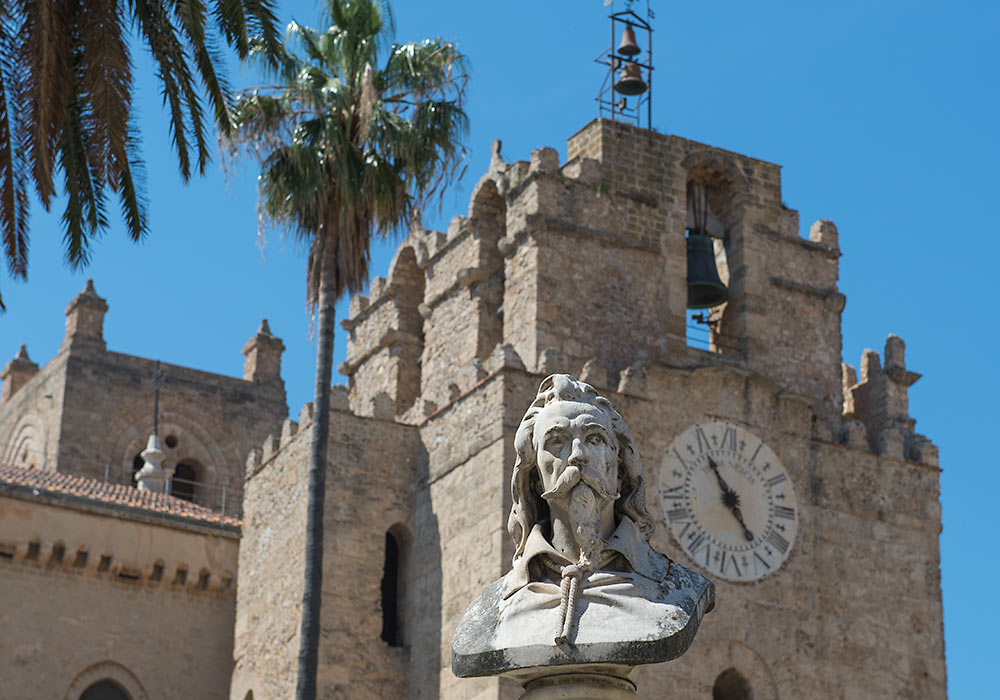
Statue of the painter Pietro Novelli (1603–1647) in front of the bell tower of the cathedral in Monreale, Palermo. Pietro Novelli was a painter of the Baroque period, active mainly in Palermo. Novelli was born in Monreale, and is known as il Monrealese or Pietro "Malta" Novelli to distinguish him from his father, Pietro Antonio Novelli.
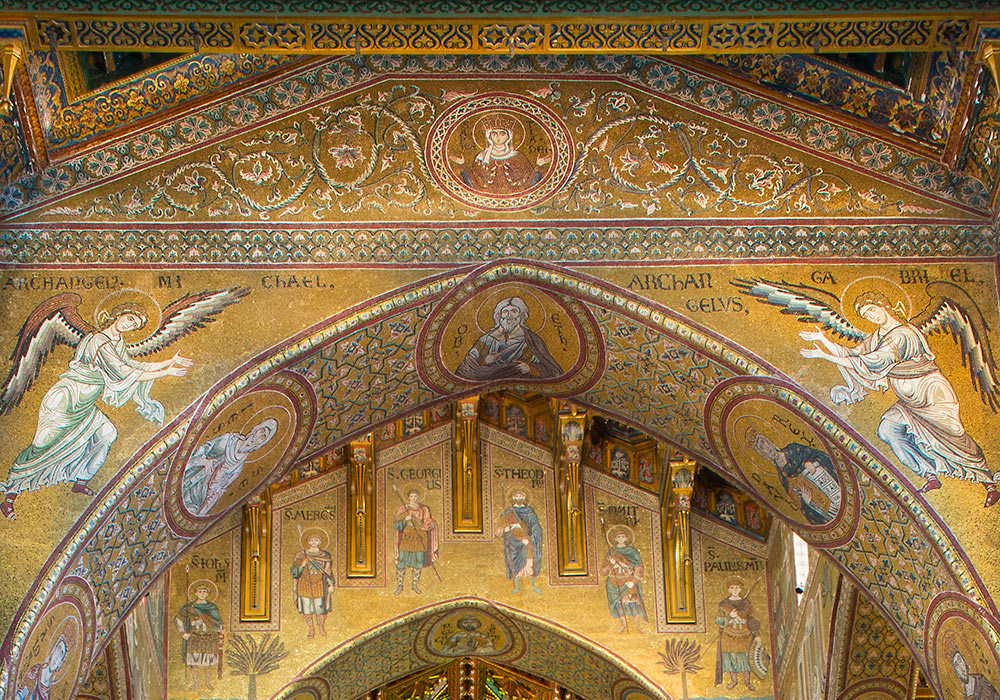
The magnificent golden interior of the Monreale cathedral.
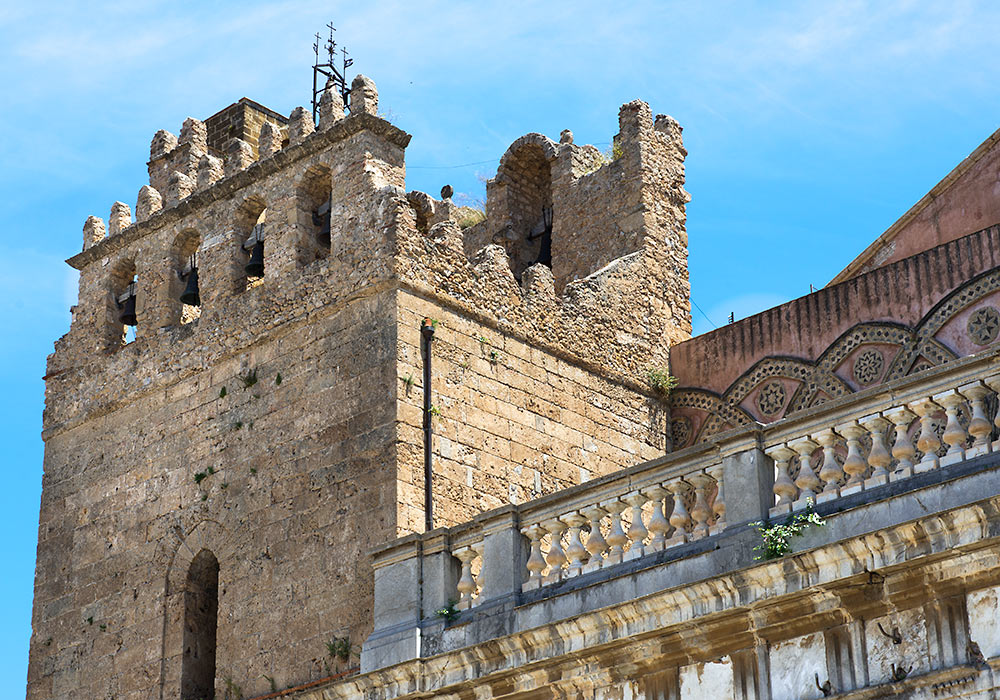
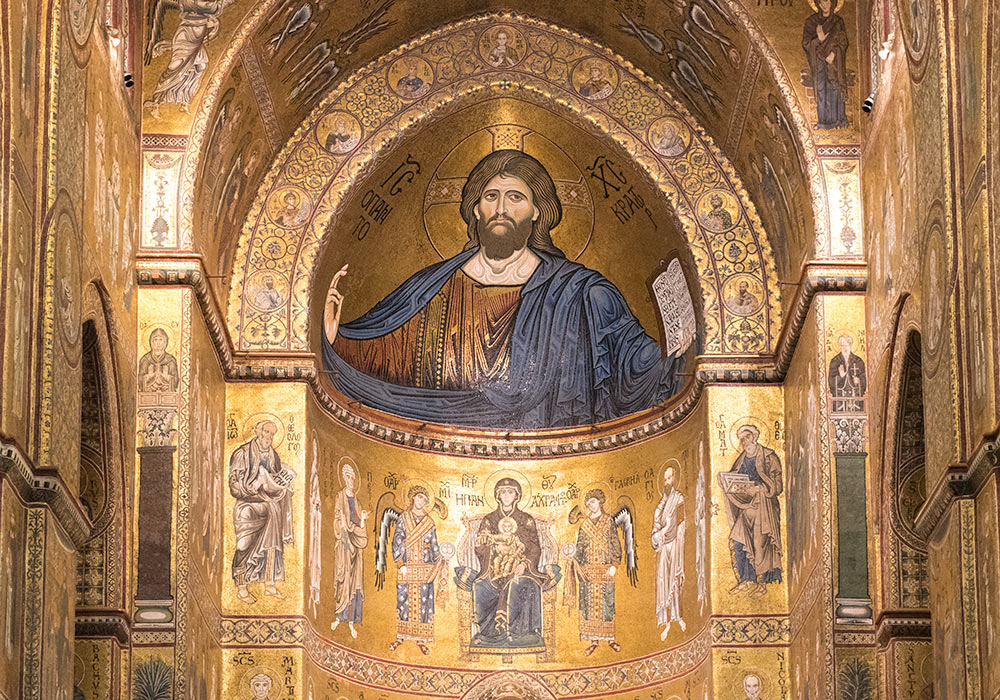
Christ Pantocrator. Monreale Cathedral, apsis.
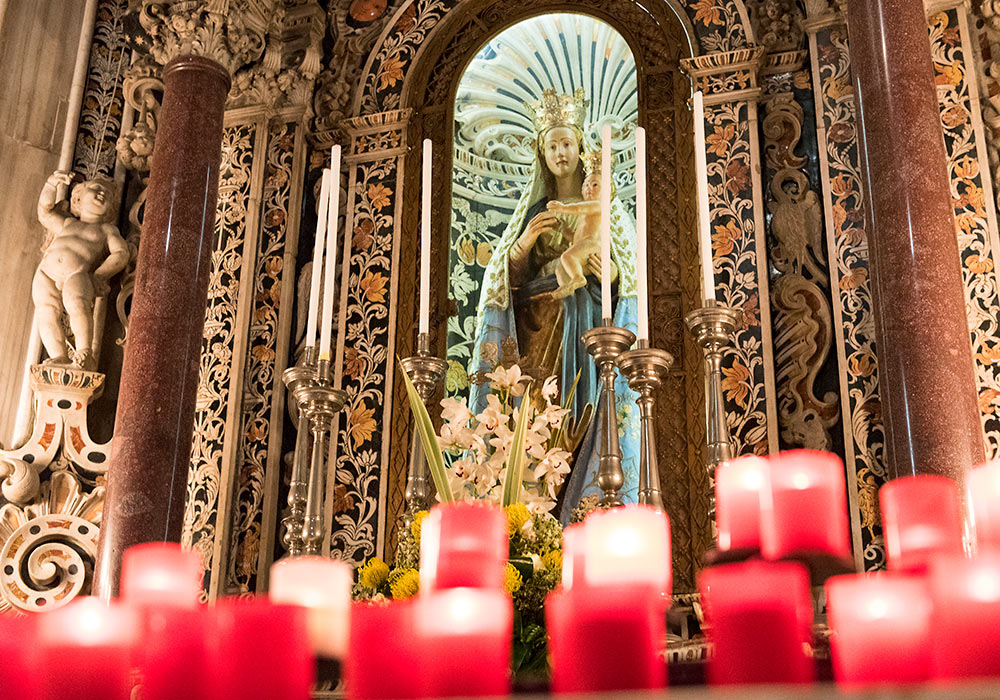
Chapel in the Monreale Cathedral.
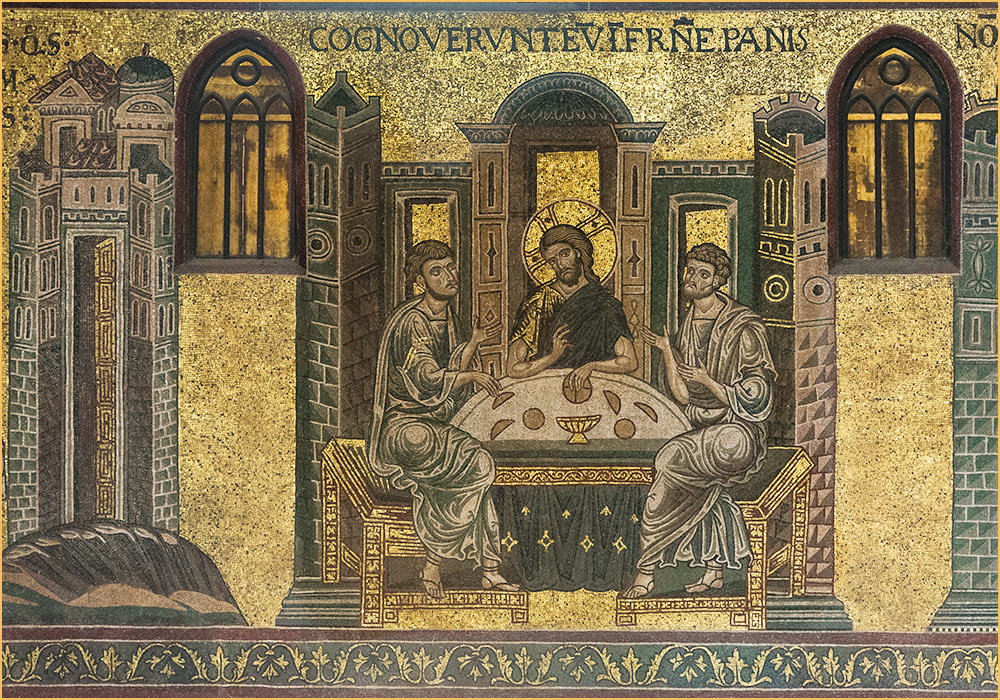
Cognoverunt eum in fractione panis: "Then the two told what had happened on the way, and how Jesus was recognized by them when he broke the bread" (Luke 24,35 - New International Version). Mosaic in the cathedral.
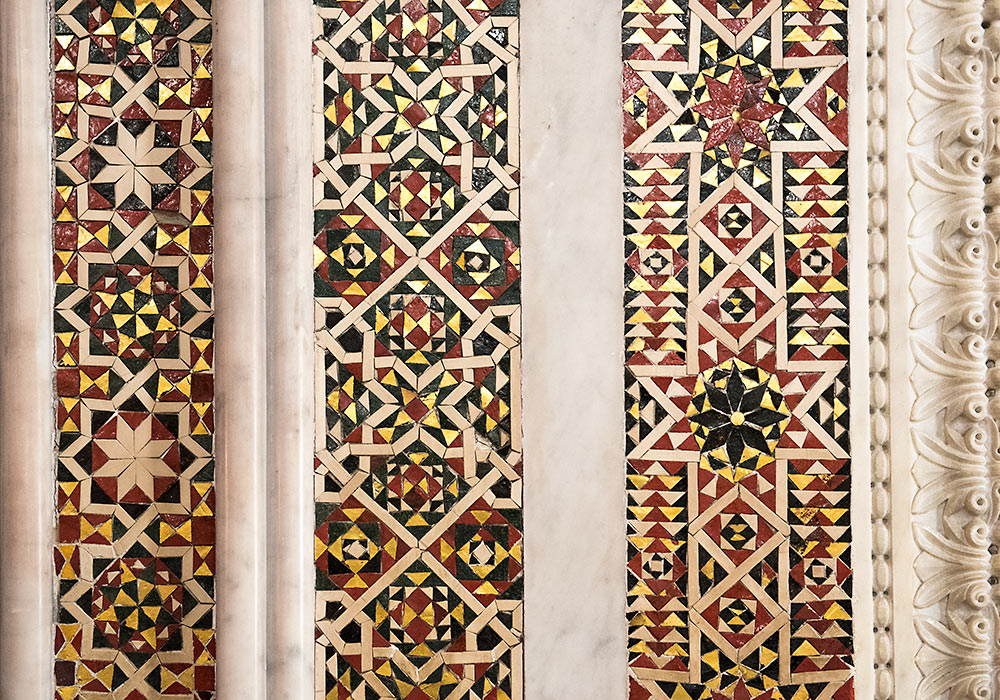
Abstract geometric patterns. Inlaid stone on the wall.
The Benedictine Cloister, Monreale
The Benedictine Cloister was completed c. 1200. It measures 47x47 metres and is located on the south side of the cathedral. Each side has 26 arches resting on columns. The splendid capitals include narrative cycles from the Old and New Testaments.
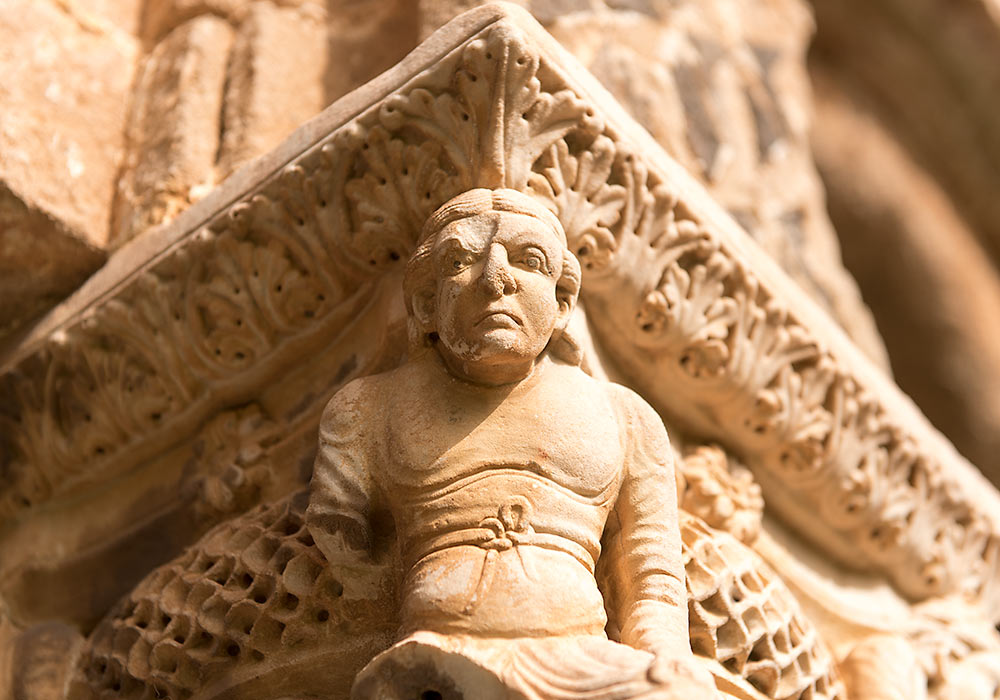
The capitals in the cloister of the abbey of Monreale were carved from white marble, but over time has acquired a thick, sandstone patina that covers them almost entirely.
CLICK HERE to see photos from the cloister at Monreale!
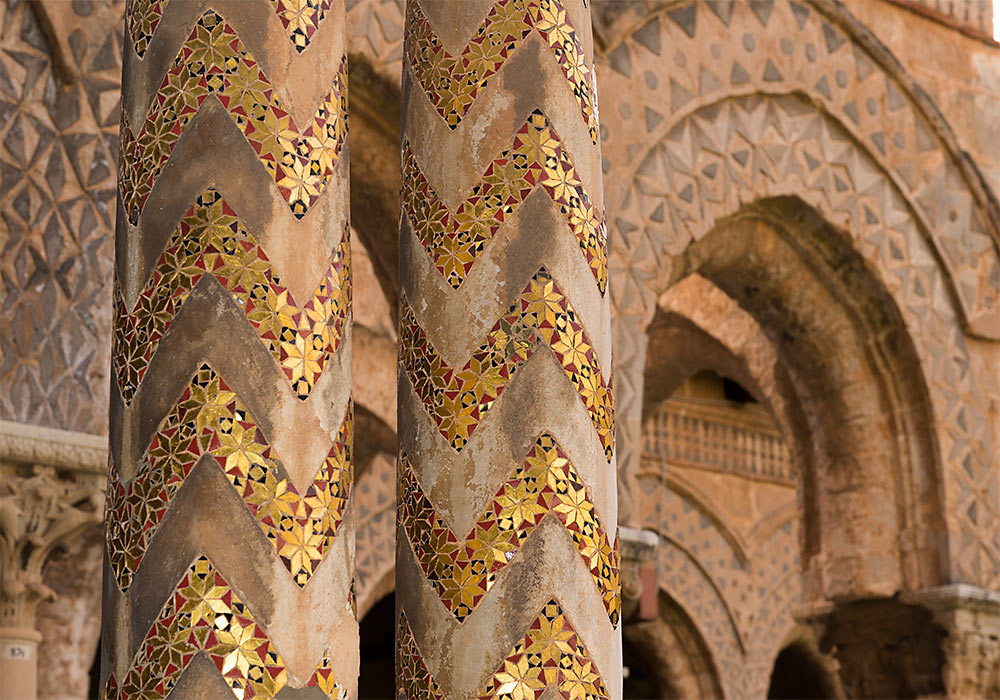
Many of the columns are richly decorated, inlaid with colored stones.
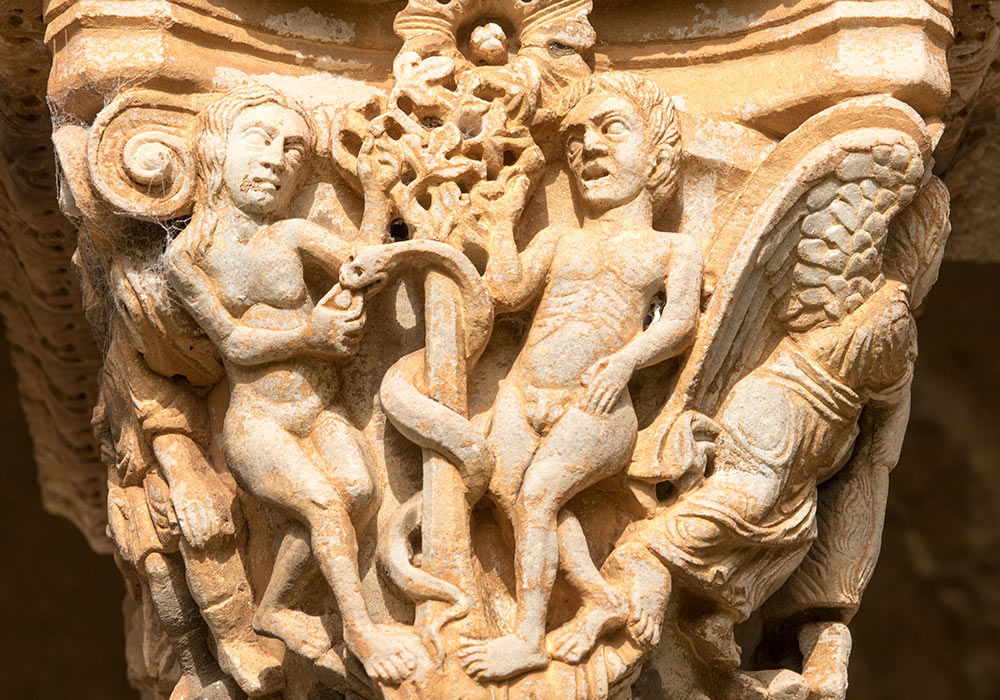
Adam and Eve are shown naked next to the Tree of Knowledge. Eve reaches for the forbidden fruit.
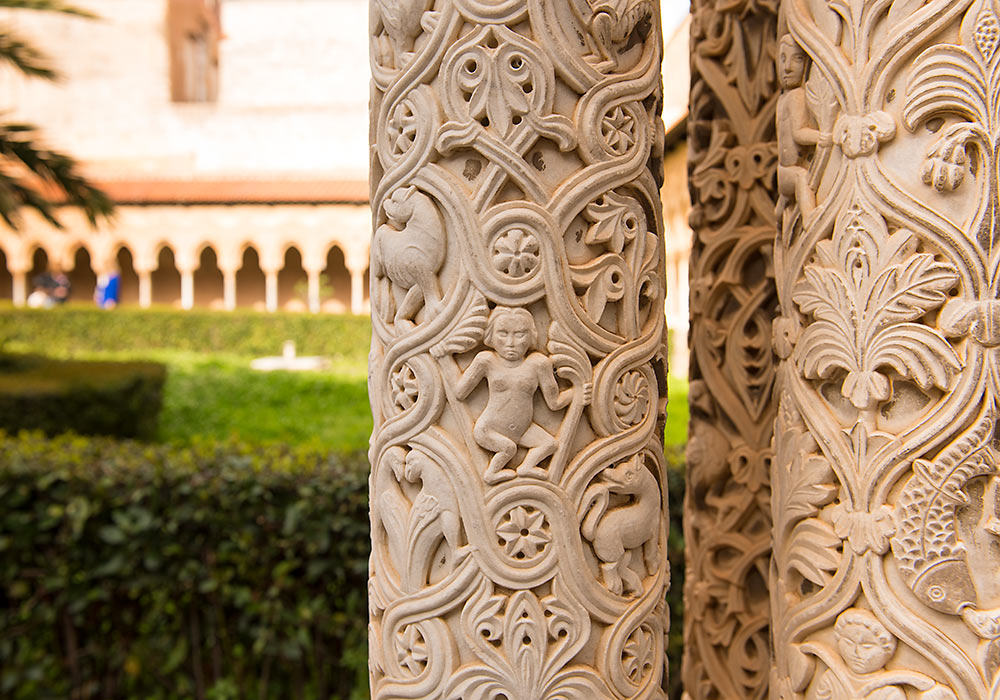
Some of the columns have beautifully carved ornaments with various motives.
CLICK HERE to see photos from the cloister at Monreale!
Related links
- Depictions of Jesus (as Christ Pantocrator) in Sicily
- The Monreale Cathedral
- The Cefalù Cathedral
- Mosaics in Sicily
- Churches in Sicily
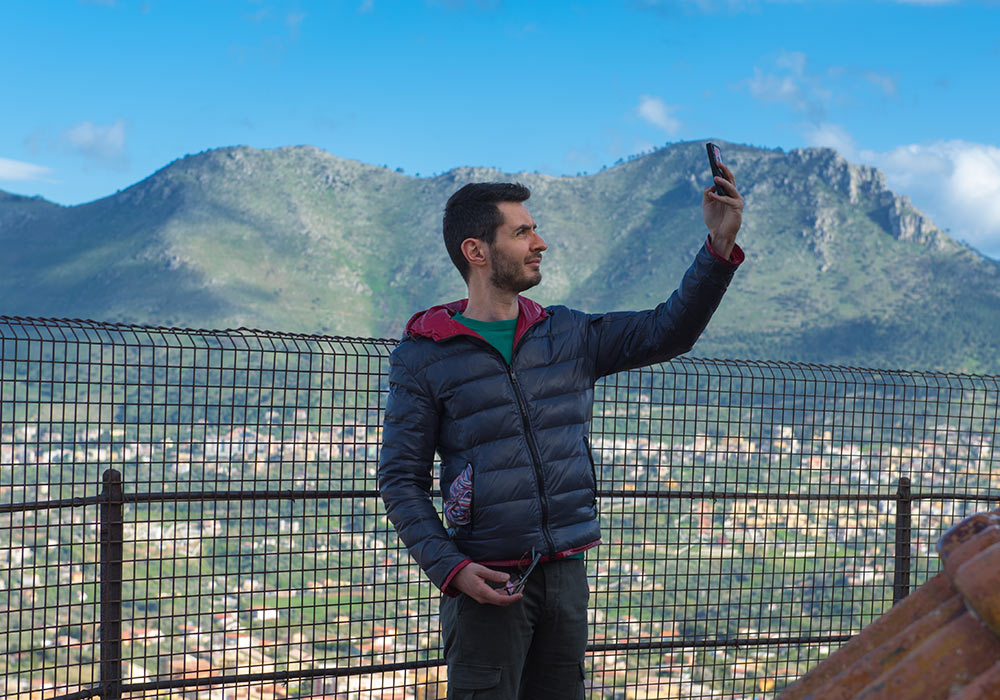
The view from the roof of the Monreale Cathedral is spectacular and the perfect location for a selfie.
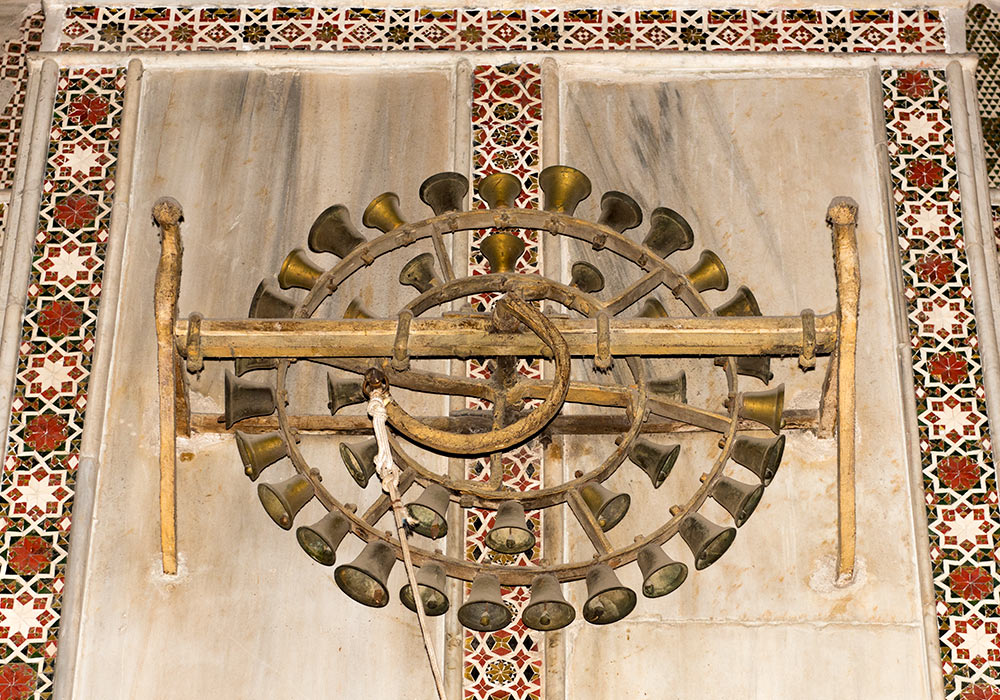
Bell wheel.
The North Door made by Barisano da Trani (c. 1179)
The Monreale Cathedral's bronze North door was made by Barisano da Trani. Barisano used a technique of low relief casting finished by chiselling.
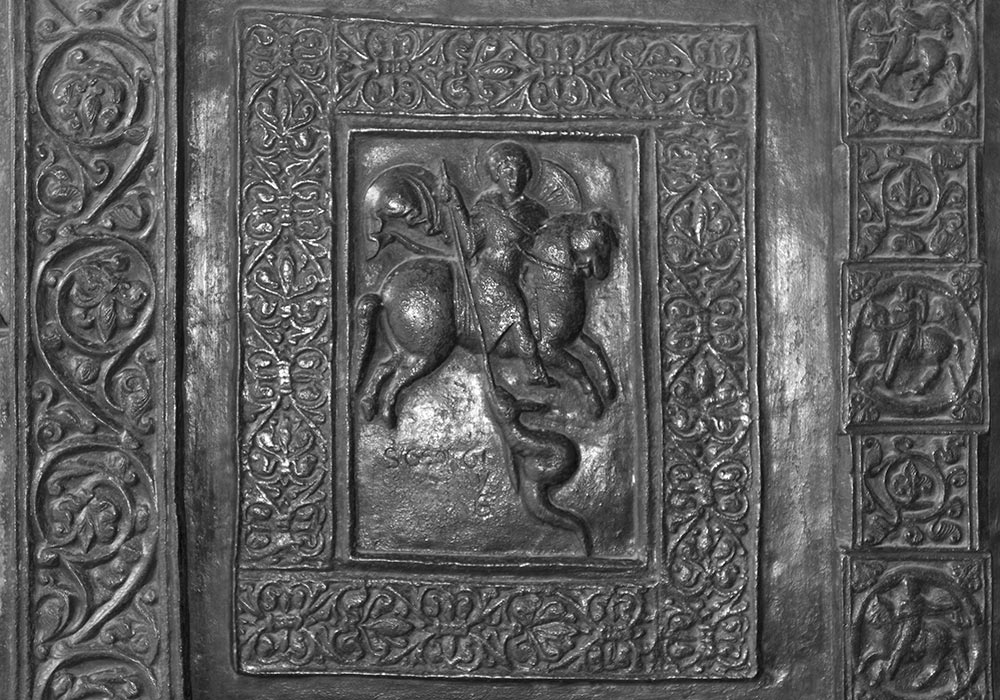
St. George (San Giorgio) killing the dragon. Detail of the bronze North Door. The figure is almost identical to Barisano's parallell on the bronze doors of the Trani Cathedral.
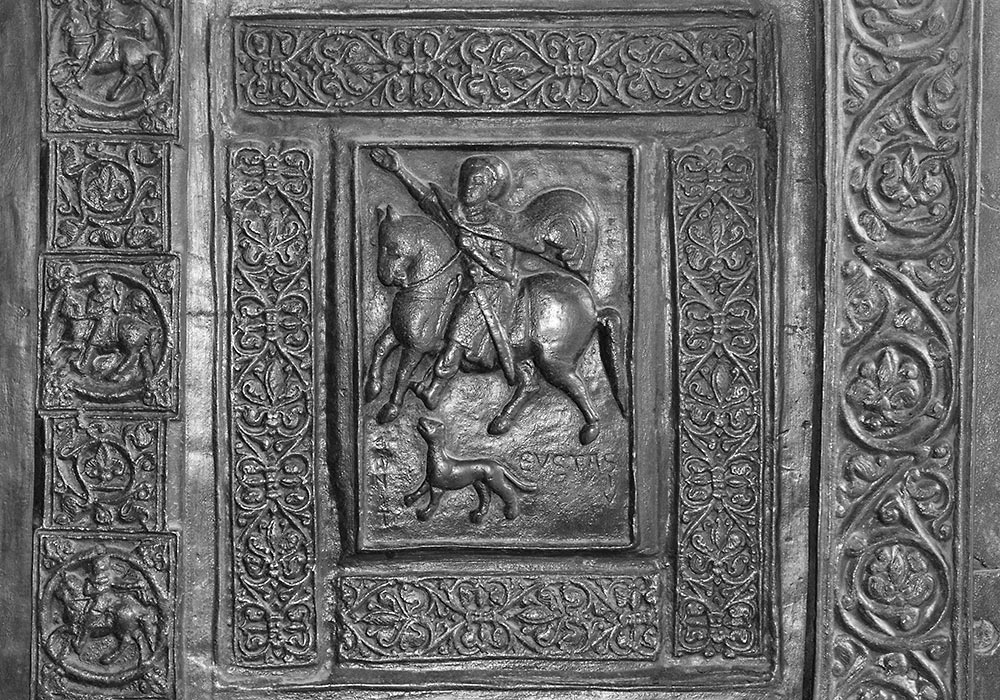
Correct me if I am wrong, but I think this shows Saint Eustace of Luxeuil (c. 560 – c. 629), also known as Eustasius, the second abbot of Luxeuil from 611.
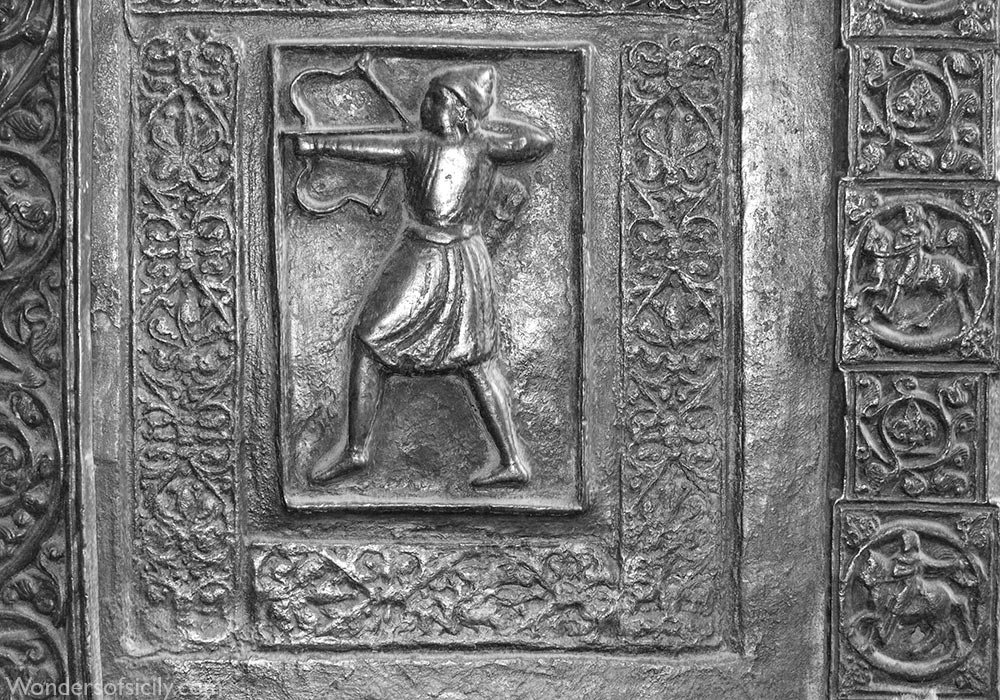
The stereotype of a Jew wearing a hat called pileus cornutus. The archer is often trying to shoot down birds in the Tree of Life, like the archers (without Jewish hats though) in the mosaic at the Zisa Castle.
Read more about the Jewish hat here…
The West Door made by Bonanno da Pisa (c. 1186)
Bonanno da Pisa (who had previously made the doors for the Cathedral in Pisa) made the bronze West Door of the Monreale Cathedral.
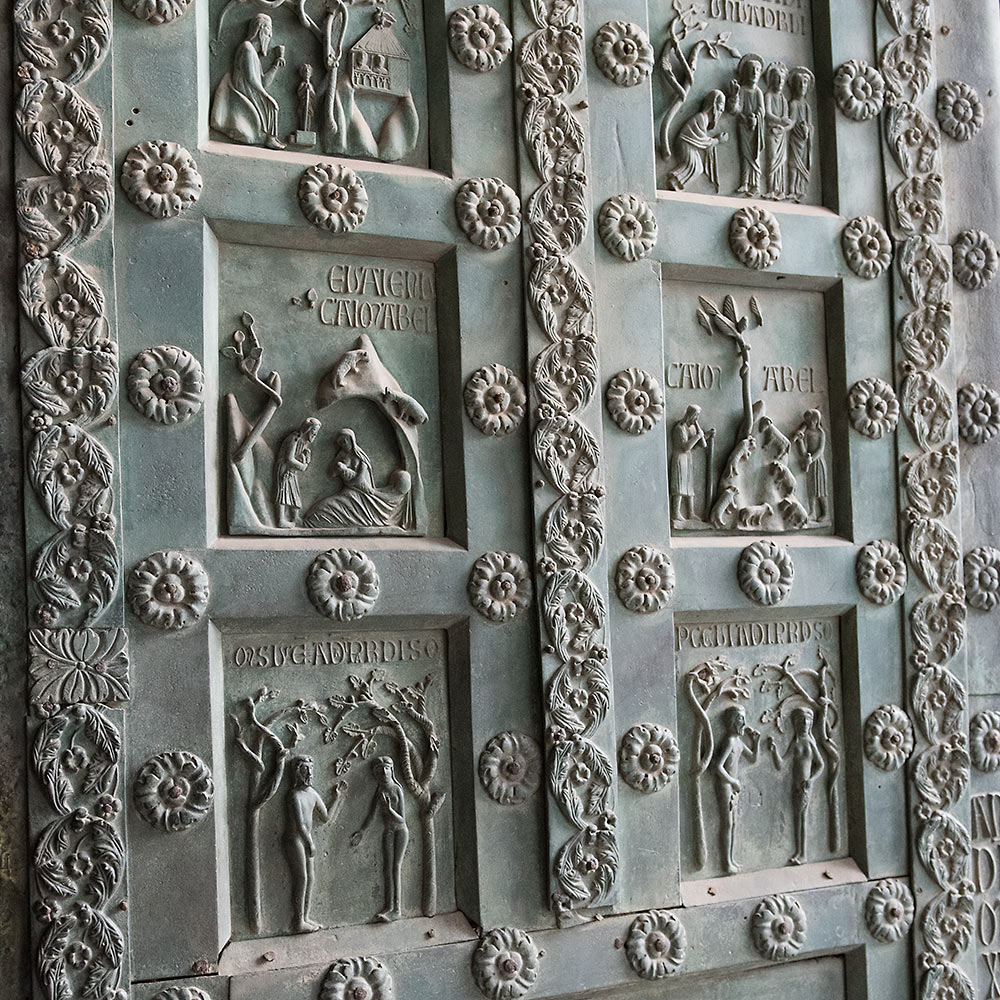
Detail of Bonanno da Pisa's bronze door (c. 1186) in Monreale.
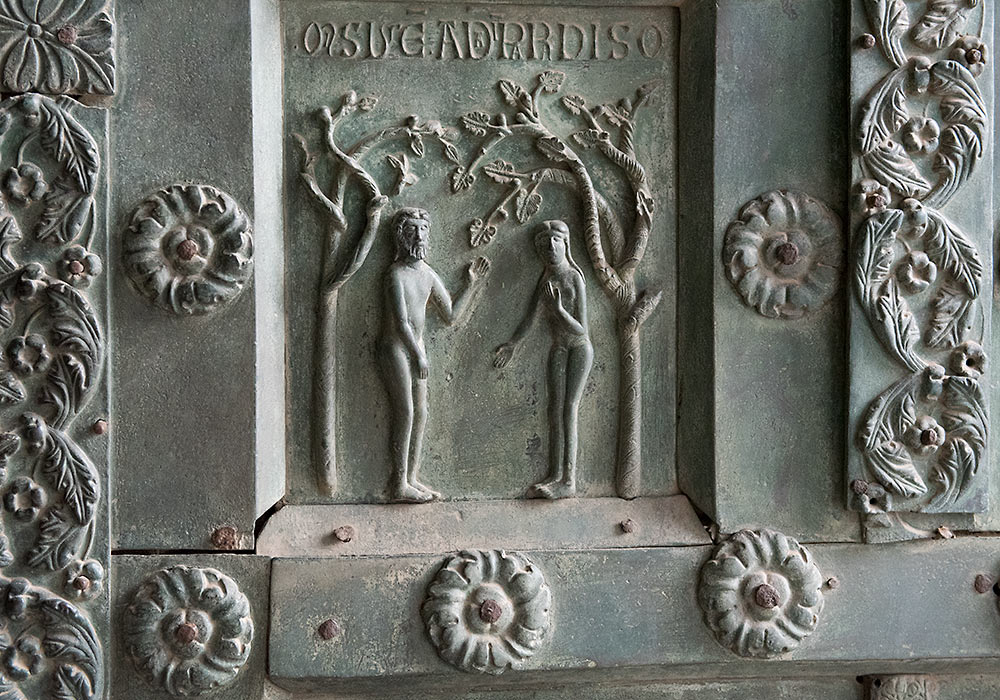
Adam and Eve: Detail of Bonanno da Pisa's bronze door (c. 1186) in Monreale.
CLICK HERE to see more photos from Palermo!
Facts about Palermo
- In 1500 the population in Palermo was approximately one million!
- When the Normans ruled over Sicily, there was around 300 mosques in Palermo.
- Boccaccio's Decameron Fifth Day - Novel VI takes place in the Cuba, Palermo (commissioned in 1180 by William II)
- The opera composer Richard Wagner finished his last work Parsifal in Palermo. In 1881–1882 he stayed with his family in Sicily.
- The population (2013) in Palermo is 654,858 (city) 1,200,000 (metro).
- Gebel Grin is what the Arabs called Monte Pellegrino, Palermo.
Sources
- Lisa Sciortino: The Cathedral of Monreale
- Ellen Grady: Blue Guide Sicily
- More sources and recommended reading here!

